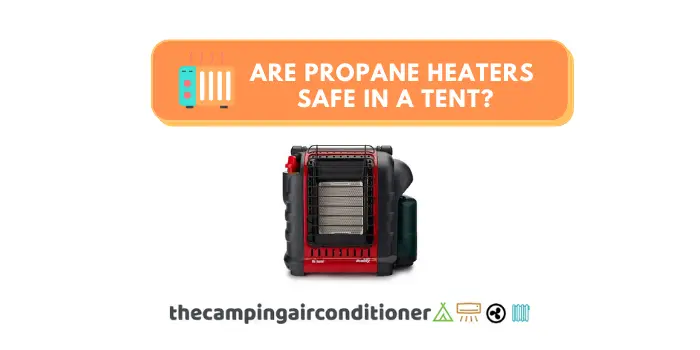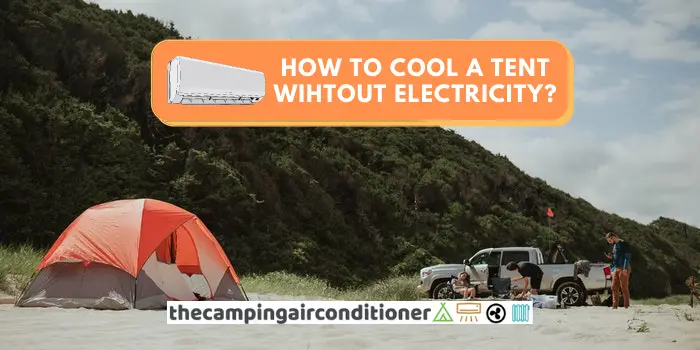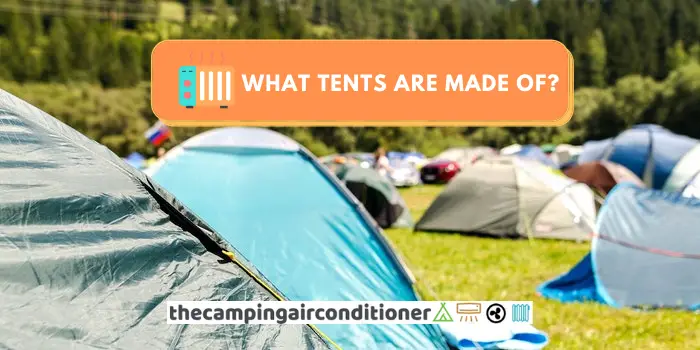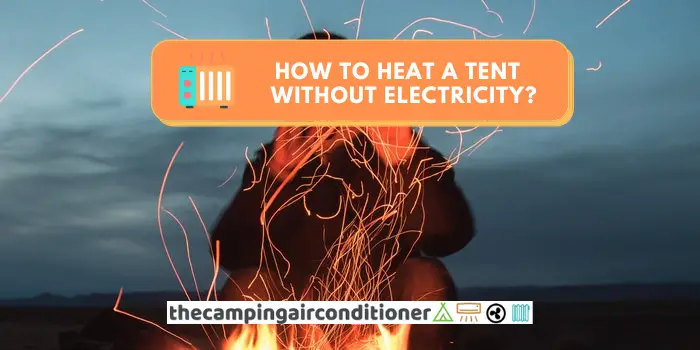Camping in the winter is a different experience than camping in the spring, summer, and fall. Even though staying outdoors with the snow may sound scary at first, you will be prepared for a winter adventure with the right gear and hacks.
Snow camping can be daunting, and to ensure you are safe, make sure that:
- Choose the best location to pitch your tent and secure it – avoid a campsite that is sloppy
- Bring adequate camping gear (winter tents or hot tents, snow stakes, sleeping bags, tent heaters, etc. )
- Wear the proper clothing and dress in multiple layers
- Create a thermal barrier and insulate your tent
- Always stay dry
- Urinate more often to avoid losing body heat
- Stay off areas with animal tracks, like bears.
Let’s go through these tips and below and answer some important questions about camping in freezing weather.
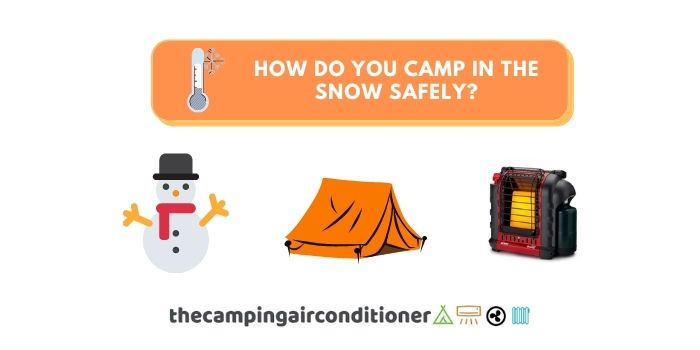
7 Tips for snow camping
Choose the best location to pitch your tent and secure it
Planning is one of the keys to successful winter camping. When it comes to the campsite, avoid pitching your tent in open areas with plenty of wind exposure.
The technique of securing a tent in the snow is not hard. First, you have to know what is around you.
Avoid setting up in areas with tree branches and bough heavy with wet snow. They snap easily, especially if a strong wind passes. One that falls on your tent can damage it or cause an injury.
Also, with rapid snowfall, consider the risk of an avalanche. Check whether the pitching area is clean and avoid any slope greater than 20-degrees because it can present an avalanche danger.
Before setting your tent, pack down and walk on the site smoothly. This will reduce the sinking due to body heat melting the snowflakes. Use a snow shovel to remove soft powder and pitch your tent on a solid base.
You can use the layer you removed to build a “snow wall” a foot high around your tent to act as a windbreak.
If you don’t have a snow shovel, walk over the pitching area gently to compact the top layer and create a solid base.
To secure the tent on the ground, ensure your tent lines hold for many anchoring points and use special snow pegs and stakes (see model below) to make sure it is properly fixed.
Finally, while camping, ensure that snow does not accumulate on your tent’s roof – excess snow build-up on the roof will cause the tent to collapse, mainly if the snow is wet.
Bring the adequate camping gear
You need to be prepared to go camping under 0 Celsius degrees, including having the right gear. On your trip, you must bring:
- A 4-season tent, such as ALPS Mountaineering Taurus 5, comes with special insulation to support freezing temperatures. If you don’t have the budget to buy a new tent and already have a 3-season tent, I recommend you read our article on how to use a 3-season tent for winter camping.
- A powerful tent heater to help you keep warm on cold nights
- If you plan to stay out for a couple of days or weeks, it might be a good idea to consider a hot tent (tents with stove jacks), which allows you to have a portable wood-burning stove inside it to keep you warm.
- A sleeping bag with a great insulation rating
- A camping stove to allow you to cook in freezing weather – consider a gas option (preferably propane) since they work well under low temperatures.
Wear proper clothing and dress in layers
Make sure you bring suitably clothes and accessories for snow camping, such as:
- Hats (or a beanie),
- Thermal socks
- Thermal gloves
- Special boots to walk in the snow and keep your feet warm, such as Columbia Bugaboot III.
- Warm pants
- Windproof and waterproof jackets, such as North Face Triclimate Waterproof Jacket
Overall, synthetic fabrics will provide better insulation, but wool is also known for its exceptional heat retention features.
As for layering, it is up to each camper. If you are always cold, it might be worth considering wearing a base thermal layer and synthetic shirts below your jacket.
Create a thermal barrier and insulate your tent
We wrote a specific article on how to insulate your tent for winter camping – read it here.
The most efficient way is to create a thermal barrier inside your tent to avoid the warm air inside it escaping outside and the freezing breeze from the outside do not enter your shelter.
To insulate your tent, you can use a tent insulation liner or use a reflective foam or foil.
Always stay dry (and keep you gear dry as well)
Staying dry is crucial to keep you warm and avoid getting sick. Moisture can make your body lose heat faster, and exposure to water for a prolonged period during winter can lead to hypothermia and frostbite.
Our tip here is to wear layers, which will allow you to keep warm and dry. If an outer layer gets wet, replace or remove it and dry it as quick as possible.
Similarly, keep your camping gear and extra clothes dry – it might be a good idea to keep electronic devices and gadgets in a bag to avoid moisture exposure (you can use a Ziploc bag!).
Urinate more often to avoid losing body heat
Maybe you never thought that peeing would influence the body’s temperature, right? In fact, it does.
Generally speaking, we tend to go more often to the bathroom on cold days. Our body tries to retain heat by compressing our internal vessels and reducing the blood flow towards our external skin.
Our blood pressure increases since we have less space in the veins to pump the same amount of fluid. As a consequence, our kidneys work more and use more water to reduce blood pressure, increasing the amount of urine in our bladder.
When bladders are full, our body tries to keep its internal liquid warm, spending more energy and deviating the focus to keep you warm. Therefore, urinating more frequently will help you keep your body’s internal temperature higher!
Interesting, isn’t it?
Stay off areas with animal tracks, like bears.
You don’t want to encounter a bear or other wild animal (i.e. foxes, coyotes, etc.) while snow camping, right? Before pitching your tent, have a quick look around your campsite and check whether you can identify any potential track traces.
Polar bears are amongst the most aggressive animals in the world and are considered extremely dangerous for humans. This article details how to multiple animal tracks on the snow.
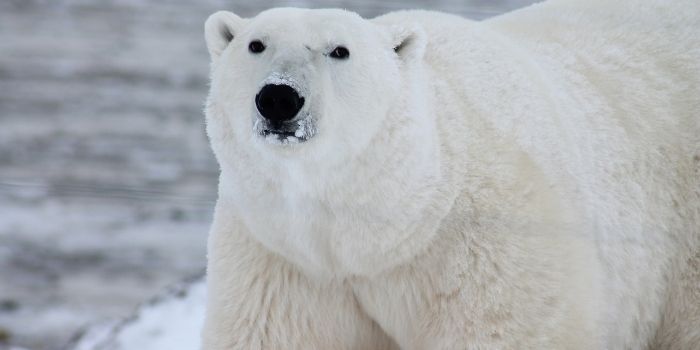
FAQ
How do campers stay warm in the snow?
With the proper preparation, winter camping can be an enjoyable experience. However, if you are not prepared, it can be miserable, and you might even need to finish won’t even finish your adventure.
On your next winter camping trip, here are essential tips you can use to keep warm:
- Dress in multiple layers to give you enough control over regulating the body temperature
- Instead of one sleeping pad, have two. Two sleeping pads provide more warmth than one pad
- Layer your winter sleeping bag with a feather-weight quilt for warmth
- Put on a balaclava to trap heat and increase the overall body heat
- Vent your tent partially to let the trapped moisture escape
- Wear heated boots, heated gloves, and hand warmers.
Can a tent withstand snow?
Ensuring your tent is not topped with snow during winter camping is vital.
This prevents the tent from sagging and tearing because of the excess pressure. Every tent is unique in its way, depending on the design.
It can be tricky to determine how much snow a wall tent can withstand. Snows vary significantly in weight due to outside temperature, snow’s composition, and many more. Generally, the larger the tent’s canvas, the more snow it can withstand.
Your tent should be constructed from sturdy materials that will withstand tear, and it should have ample insulation, which will ensure you are warm in the cold.
Even with a 16″ x 24″ tent, your tent can still be damaged by snow. So, take important measures to protect your tent, frame, and fabric.
In snow camping, avoid purchasing a tent with a large surface area because it will carry more snow load, which increases the chances of your tent collapsing. If possible, have your tent roof slightly inclined, which helps to prevent snow accumulation.
Keep in mind that wet snow can be three times heavier than the same volume of dry snow.
What is a winterized tent?
Ensuring your tent is not topped with snow during winter camping is vital.
This prevents the tent from sagging and tearing because of the excess pressure. Every tent is unique in its way, depending on the design.
It can be tricky to determine how much snow a wall tent can withstand. Snows vary significantly in weight due to outside temperature, snow’s composition, and many more. Generally, the larger the tent’s canvas, the more snow it can withstand.
Your tent should be constructed from sturdy materials that will withstand tear, and it should have ample insulation, which will ensure you are warm in the cold.
Even with a 16″ x 24″ tent, your tent can still be damaged by snow. So, take important measures to protect your tent, frame, and fabric.
In snow camping, avoid purchasing a tent with a large surface area because it will carry more snow load, which increases the chances of your tent collapsing. If possible, have your tent roof slightly inclined, which helps to prevent snow accumulation.
Keep in mind that wet snow can be three times heavier than the same volume of dry snow.
How do you winterproof a tent?
Staying warm while winter camping can be a challenge. High winds, cold temperatures, and excess snowfall create harsh conditions that make it hard to sleep.
However, some ways can help keep your tent comfortable in the winter. Here are ways you can insulate your tent to stay warm:
- Bring a small tent so that you can close as much open space as possible to prevent cold from creeping in
- Use a thermal blanket to cover the tent
- Block the wind using a tarp
- Build a windbreak out of snow
- Use a sleeping pad under the sleeping bag to keep you warmer
- Use a tent insulation liner, such as Crua Outdoors Culla Maxx
Conclusion
Camping in the snow can be an excellent alternative for winter days if you have the right gear and camping accessories.
These 7 tips shown in this post will help you have a safe and enjoyable trip and make your snow camping unique!
Have a safe camping trip!




